腹腔镜器械清洗与消毒
- 格式:ppt
- 大小:8.56 MB
- 文档页数:45

腹腔镜器械的清洗、消毒及管理【关键词】腹腔镜术;消毒;手术器械我院自1999年开展第1例腹腔镜手术至今,已成功实施514例,效果满意。
现将我们的体会报道如下。
1 临床资料本组514例中男299例,女215例,13~76岁,平均45岁。
其中普外科手术367例,妇科手术123例,泌尿外科手术24例。
住院时间3~12d,平均6d,切口愈合良好,住院期间无院内感染发生。
2 器械的清洗和消毒2.l 腹腔镜器械的清洗方法清洗是消毒和灭菌中的一个重要环节,通过清洗能去除器械90%以上的病原体。
目前腹腔镜器械的清洗有人工和使用超声自动清洗机两种方法。
因后者价格昂贵,所以我们采用的是人工清洗法,通常采用的程序是:酶泡清洗消毒清洗干燥灭菌。
手术完毕后,立即将腹腔镜器械放在含酶消毒清洁剂里浸泡30min,因酶可迅速分解蛋白质和有机物,使残留血液、有机物、粘液等不至于凝固而吸附在器械上,从而易于清洗。
并将所有能拆卸的部件全部取下,分开放置,各套管芯拔出,充分浸泡。
然后用流动自来水认真清洗每一部件,带有管腔的器械应用注射器注入清水冲洗,再用柔软的毛刷反复洗刷,以两端见刷头为准,彻底清除所有的组织碎片,同时去除其他有机物。
清洗干净后将各部件完全浸泡在2%碱性戊二醛消毒液30min 后取出。
用流动自来水冲洗干净后,放在器械专用润滑液里润滑约2min后取出,并将各关节、各钳叶打开,气腹管及有管腔的器械用吹风机吹干或注入70%乙醇后再用加压空气吹干,使其充分干燥,横放或悬挂在阴凉干燥的专用贮存柜内备用。
2.2 腹腔镜器械的消毒方法最理想的内镜消毒剂应有杀菌效果可靠、作用迅速、无毒、无刺激、不致敏、性能稳定、使用方便等优点。
而目前仅有强生的等离子消毒能完全符合上述条件,但此设备过于昂贵,国内多数医院不能实现。
现介绍我院常用的几种消毒方法。
戊二醛浸泡法2%碱性戊二醛消毒液是一种高效广谱消毒剂。
消毒时,须将器械的各关节、各部件完全浸泡,又因气腹管和管腔器械是交叉感染的重要贮源,因此管腔内均应贮满消毒液。
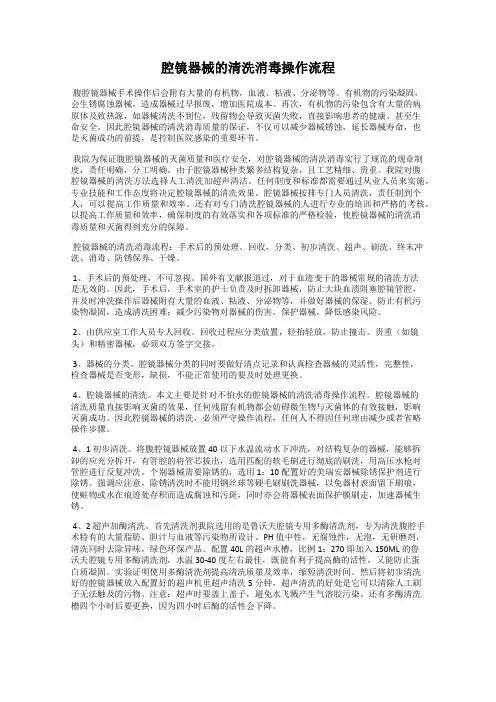
腔镜器械的清洗消毒操作流程腹腔镜器械手术操作后会附有大量的有机物,血液、粘液、分泌物等。
有机物的污染凝固,会生锈腐蚀器械,造成器械过早报废,增加医院成本。
再次,有机物的污染包含有大量的病原体及致热源,如器械清洗不到位,残留物会导致灭菌失败,直接影响患者的健康、甚至生命安全。
因此腔镜器械的清洗消毒质量的保证,不仅可以减少器械锈蚀,延长器械寿命,也是灭菌成功的前提,是控制医院感染的重要环节。
我院为保证腹腔镜器械的灭菌质量和医疗安全,对腔镜器械的清洗消毒实行了规范的规章制度,责任明确,分工明确。
由于腔镜器械种类繁多结构复杂,且工艺精细、贵重。
我院对腹腔镜器械的清洗方法选择人工清洗加超声清洁。
任何制度和标准都需要通过从业人员来实施,专业技能和工作态度将决定腔镜器械的清洗效果。
腔镜器械按排专门人员清洗,责任制到个人,可以提高工作质量和效率。
还有对专门清洗腔镜器械的人进行专业的培训和严格的考核,以提高工作质量和效率,确保制度的有效落实和各项标准的严格检验,使腔镜器械的清洗消毒质量和灭菌得到充分的保障。
腔镜器械的清洗消毒流程:手术后的预处理、回收、分类、初步清洗、超声、刷洗、终末冲洗、消毒、防锈保养、干燥。
1、手术后的预处理,不可忽视。
国外有文献报道过,对于血迹变干的器械常规的清洗方法是无效的。
因此,手术后,手术室的护士负责及时拆卸器械,防止大块血渍阻塞腔镜管腔,并及时冲洗操作后器械附有大量的血液、粘液、分泌物等,并做好器械的保湿。
防止有机污染物凝固,造成清洗困难;减少污染物对器械的伤害,保护器械,降低感染风险。
2、由供应室工作人员专人回收。
回收过程应分类放置,轻抬轻放,防止撞击。
贵重(如镜头)和精密器械,必须双方签字交接。
3、器械的分类。
腔镜器械分类的同时要做好清点记录和认真检查器械的灵活性,完整性,检查器械是否变形,缺损,不能正常使用的要及时处理更换。
4、腔镜器械的清洗。
本文主要是针对不怕水的腔镜器械的清洗消毒操作流程。
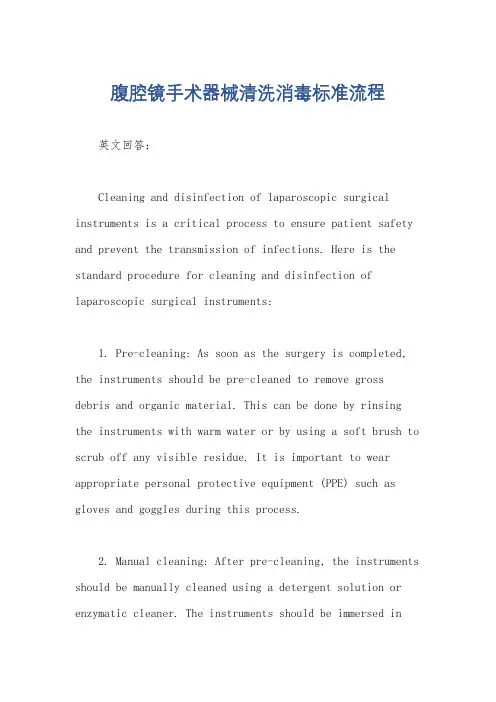
腹腔镜手术器械清洗消毒标准流程英文回答:Cleaning and disinfection of laparoscopic surgical instruments is a critical process to ensure patient safety and prevent the transmission of infections. Here is the standard procedure for cleaning and disinfection of laparoscopic surgical instruments:1. Pre-cleaning: As soon as the surgery is completed, the instruments should be pre-cleaned to remove gross debris and organic material. This can be done by rinsing the instruments with warm water or by using a soft brush to scrub off any visible residue. It is important to wear appropriate personal protective equipment (PPE) such as gloves and goggles during this process.2. Manual cleaning: After pre-cleaning, the instruments should be manually cleaned using a detergent solution or enzymatic cleaner. The instruments should be immersed inthe solution and scrubbed gently with a soft brush to remove any remaining organic material. Pay attention to the hinges, joints, and crevices where debris may accumulate. Rinse the instruments thoroughly with water to remove any detergent residue.3. Ultrasonic cleaning: After manual cleaning, the instruments should undergo ultrasonic cleaning. The instruments are placed in an ultrasonic cleaner filled with a cleaning solution. The ultrasonic waves create high-frequency vibrations that help to dislodge any remaining debris from the instruments. This process should be carried out for a specific duration as recommended by the manufacturer.4. Inspection: After ultrasonic cleaning, the instruments should be visually inspected for any signs of damage or residual debris. Any damaged or malfunctioning instruments should be removed from circulation and sent for repair or replacement. It is important to ensure that all instruments are thoroughly cleaned and free from anyvisible debris before proceeding to the next step.5. Drying: Once the instruments have been inspected, they should be dried thoroughly to prevent the growth of microorganisms. This can be done by air-drying or by using a clean, lint-free cloth. It is important to ensure that the instruments are completely dry before proceeding to the next step.6. Packaging: After drying, the instruments should be properly packaged to maintain their sterility. This can be done by placing the instruments in sterilization pouches or wrapping them in sterile packaging material. The packaging should be sealed securely to prevent contamination.7. Sterilization: The packaged instruments should undergo sterilization using an appropriate method such as steam sterilization or ethylene oxide sterilization. The sterilization process should be carried out according to the manufacturer's instructions and guidelines.8. Storage: Once the instruments have been sterilized, they should be stored in a clean and dry environment.Proper storage helps to maintain the sterility of the instruments until they are ready to be used in the next surgery.中文回答:腹腔镜手术器械的清洗和消毒是确保患者安全和预防感染传播的关键过程。
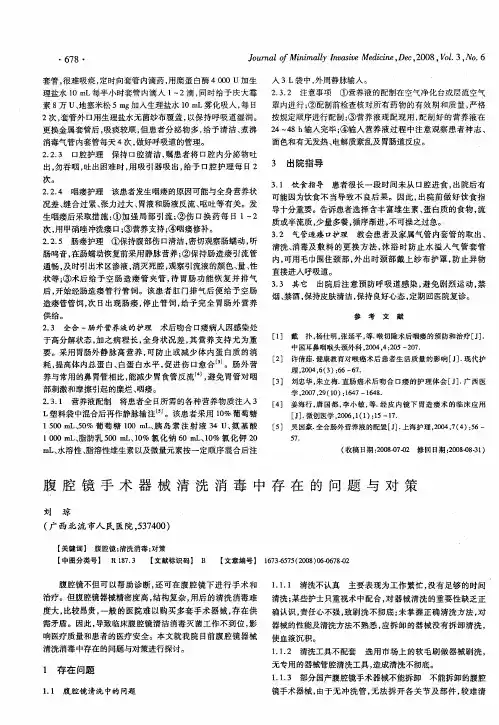
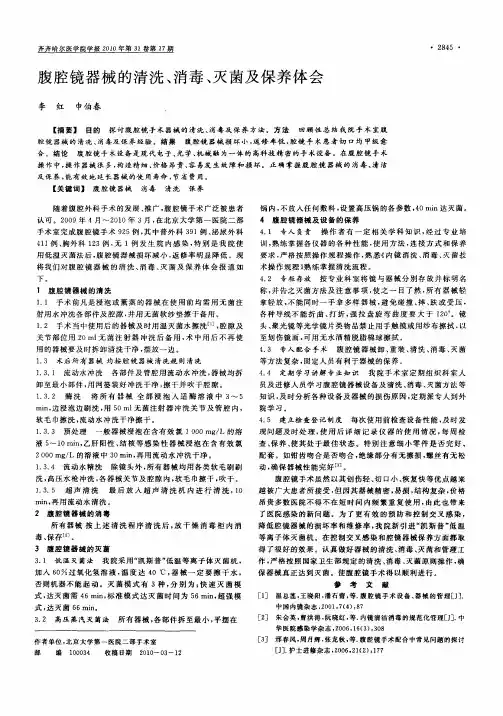
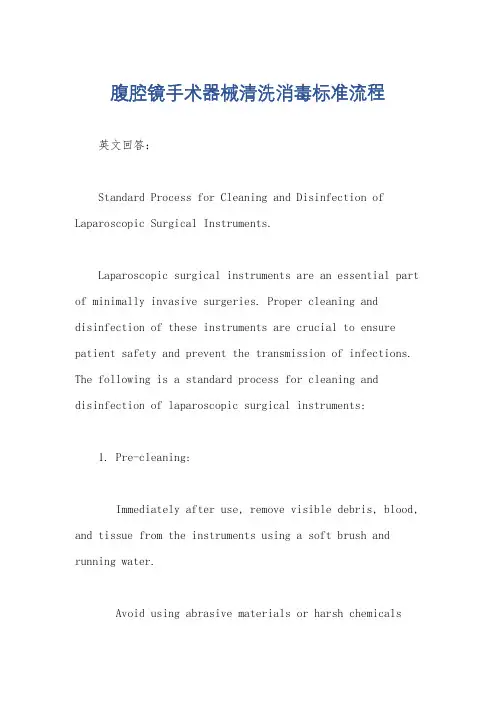
腹腔镜手术器械清洗消毒标准流程英文回答:Standard Process for Cleaning and Disinfection of Laparoscopic Surgical Instruments.Laparoscopic surgical instruments are an essential part of minimally invasive surgeries. Proper cleaning and disinfection of these instruments are crucial to ensure patient safety and prevent the transmission of infections. The following is a standard process for cleaning and disinfection of laparoscopic surgical instruments:1. Pre-cleaning:Immediately after use, remove visible debris, blood, and tissue from the instruments using a soft brush and running water.Avoid using abrasive materials or harsh chemicalsthat can damage the instruments.Rinse the instruments thoroughly to remove any remaining debris.2. Manual cleaning:Submerge the instruments in an enzymatic detergent solution, following the manufacturer's instructions.Use a soft brush or sponge to clean all surfaces of the instruments, paying special attention to hinges, joints, and crevices.Rinse the instruments thoroughly with clean water to remove any detergent residue.3. Ultrasonic cleaning:Place the instruments in an ultrasonic cleaning bath filled with an enzymatic detergent solution.Operate the ultrasonic cleaner according to the manufacturer's instructions, ensuring that all surfaces of the instruments are adequately exposed to the ultrasonic waves.Rinse the instruments thoroughly with clean water to remove any detergent residue.4. Inspection:Visually inspect the instruments for any signs of damage, such as corrosion, pitting, or loose parts.Ensure that all hinges, joints, and movable parts are functioning properly.Any damaged or malfunctioning instruments should be removed from service and sent for repair or replacement.5. Drying:Thoroughly dry the instruments using a lint-freecloth or air-drying cabinet.Ensure that all moisture is removed to prevent the growth of microorganisms.6. Packaging and sterilization:Place the dried instruments in sterilization pouches or containers suitable for the sterilization method to be used.Follow the sterilization guidelines and protocols recommended by the manufacturer.7. Storage:Store the sterilized instruments in a clean and dry environment, protected from dust and contamination.Regularly check the instruments for any signs of damage or deterioration during storage.中文回答:腹腔镜手术器械清洗消毒标准流程。
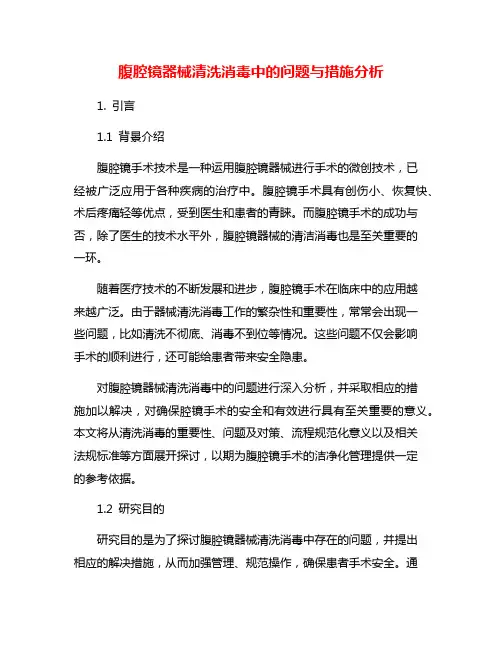
腹腔镜器械清洗消毒中的问题与措施分析1. 引言1.1 背景介绍腹腔镜手术技术是一种运用腹腔镜器械进行手术的微创技术,已经被广泛应用于各种疾病的治疗中。
腹腔镜手术具有创伤小、恢复快、术后疼痛轻等优点,受到医生和患者的青睐。
而腹腔镜手术的成功与否,除了医生的技术水平外,腹腔镜器械的清洁消毒也是至关重要的一环。
随着医疗技术的不断发展和进步,腹腔镜手术在临床中的应用越来越广泛。
由于器械清洗消毒工作的繁杂性和重要性,常常会出现一些问题,比如清洗不彻底、消毒不到位等情况。
这些问题不仅会影响手术的顺利进行,还可能给患者带来安全隐患。
对腹腔镜器械清洗消毒中的问题进行深入分析,并采取相应的措施加以解决,对确保腔镜手术的安全和有效进行具有至关重要的意义。
本文将从清洗消毒的重要性、问题及对策、流程规范化意义以及相关法规标准等方面展开探讨,以期为腹腔镜手术的洁净化管理提供一定的参考依据。
1.2 研究目的研究目的是为了探讨腹腔镜器械清洗消毒中存在的问题,并提出相应的解决措施,从而加强管理、规范操作,确保患者手术安全。
通过分析清洗消毒过程中可能出现的问题,总结问题应对措施,探讨清洗消毒流程规范化的意义,深入了解相关法规和标准,以便更好地指导实践操作。
通过本文的研究,希望能够加强腹腔镜器械清洗消毒管理意识,推动规范化操作的实施,为未来发展提供重要建议。
2. 正文2.1 腹腔镜器械清洗消毒的重要性腹腔镜器械清洗消毒的重要性在医疗领域中是至关重要的。
腹腔镜手术器械在手术中直接接触患者的内脏器官,如果清洗消毒不彻底会造成器械表面残留的细菌或病毒对患者产生感染风险。
清洗消毒不达标还可能导致手术失败、术后感染、并发症加重等严重后果。
腹腔镜器械清洗消毒的重要性不仅在于保障患者手术安全,也关乎医护人员的健康。
清洗消毒不当会导致医护人员职业暴露和交叉感染,给医疗单位带来法律风险和负面影响。
医疗机构和医疗人员务必严格遵守清洗消毒操作规程,确保器械的清洁、消毒和灭菌效果,以保障手术质量和医疗安全。
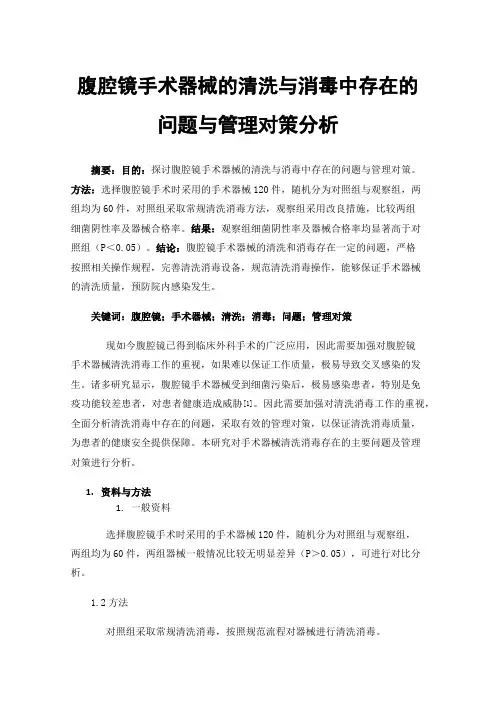
腹腔镜手术器械的清洗与消毒中存在的问题与管理对策分析摘要:目的:探讨腹腔镜手术器械的清洗与消毒中存在的问题与管理对策。
方法:选择腹腔镜手术时采用的手术器械120件,随机分为对照组与观察组,两组均为60件,对照组采取常规清洗消毒方法,观察组采用改良措施,比较两组细菌阴性率及器械合格率。
结果:观察组细菌阴性率及器械合格率均显著高于对照组(P<0.05)。
结论:腹腔镜手术器械的清洗和消毒存在一定的问题,严格按照相关操作规程,完善清洗消毒设备,规范清洗消毒操作,能够保证手术器械的清洗质量,预防院内感染发生。
关键词:腹腔镜;手术器械;清洗;消毒;问题;管理对策现如今腹腔镜已得到临床外科手术的广泛应用,因此需要加强对腹腔镜手术器械清洗消毒工作的重视,如果难以保证工作质量,极易导致交叉感染的发生。
诸多研究显示,腹腔镜手术器械受到细菌污染后,极易感染患者,特别是免疫功能较差患者,对患者健康造成威胁[1]。
因此需要加强对清洗消毒工作的重视,全面分析清洗消毒中存在的问题,采取有效的管理对策,以保证清洗消毒质量,为患者的健康安全提供保障。
本研究对手术器械清洗消毒存在的主要问题及管理对策进行分析。
1.资料与方法1.一般资料选择腹腔镜手术时采用的手术器械120件,随机分为对照组与观察组,两组均为60件,两组器械一般情况比较无明显差异(P>0.05),可进行对比分析。
1.2方法对照组采取常规清洗消毒,按照规范流程对器械进行清洗消毒。
观察组采取改良优化措施对器械进行清洗消毒,具体内容:(1)安排专业工作人员对器械进行管理,负责清洗与消毒工作,可以在一段时间后轮流操作。
(2)明确腹腔镜手术器械的专门清洗时间,配置完善的清洗系统及设施,如浸泡池、高压水枪、超声清洗机、细软毛刷等。
(3)工作人员需要及时擦干手术台上器械的血迹,清除污物。
术后工作人员将手术器械的部件全部拆开,之后放置在流动清水中进行初步清洗,将大部分污垢、血迹初步清除;完成初步清洗工作后,将器械放置在多酶液中进行浸泡处理,工作人员需要将各个器械的关节打开后进行浸泡,需要结合器械污染程度明确配制多酶液。
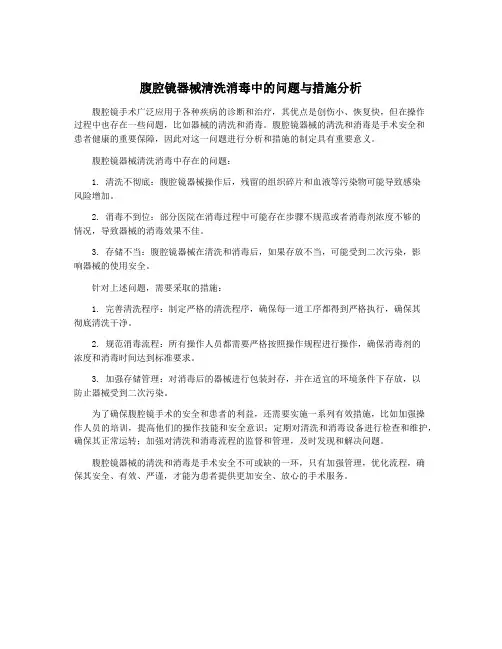
腹腔镜器械清洗消毒中的问题与措施分析
腹腔镜手术广泛应用于各种疾病的诊断和治疗,其优点是创伤小、恢复快,但在操作
过程中也存在一些问题,比如器械的清洗和消毒。
腹腔镜器械的清洗和消毒是手术安全和
患者健康的重要保障,因此对这一问题进行分析和措施的制定具有重要意义。
腹腔镜器械清洗消毒中存在的问题:
1. 清洗不彻底:腹腔镜器械操作后,残留的组织碎片和血液等污染物可能导致感染
风险增加。
2. 消毒不到位:部分医院在消毒过程中可能存在步骤不规范或者消毒剂浓度不够的
情况,导致器械的消毒效果不佳。
3. 存储不当:腹腔镜器械在清洗和消毒后,如果存放不当,可能受到二次污染,影
响器械的使用安全。
针对上述问题,需要采取的措施:
1. 完善清洗程序:制定严格的清洗程序,确保每一道工序都得到严格执行,确保其
彻底清洗干净。
2. 规范消毒流程:所有操作人员都需要严格按照操作规程进行操作,确保消毒剂的
浓度和消毒时间达到标准要求。
3. 加强存储管理:对消毒后的器械进行包装封存,并在适宜的环境条件下存放,以
防止器械受到二次污染。
为了确保腹腔镜手术的安全和患者的利益,还需要实施一系列有效措施,比如加强操
作人员的培训,提高他们的操作技能和安全意识;定期对清洗和消毒设备进行检查和维护,确保其正常运转;加强对清洗和消毒流程的监督和管理,及时发现和解决问题。
腹腔镜器械的清洗和消毒是手术安全不可或缺的一环,只有加强管理,优化流程,确
保其安全、有效、严谨,才能为患者提供更加安全、放心的手术服务。
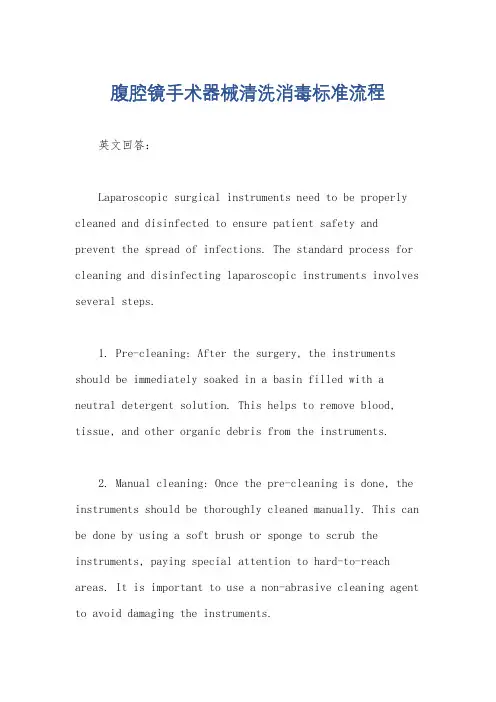
腹腔镜手术器械清洗消毒标准流程英文回答:Laparoscopic surgical instruments need to be properly cleaned and disinfected to ensure patient safety and prevent the spread of infections. The standard process for cleaning and disinfecting laparoscopic instruments involves several steps.1. Pre-cleaning: After the surgery, the instruments should be immediately soaked in a basin filled with a neutral detergent solution. This helps to remove blood, tissue, and other organic debris from the instruments.2. Manual cleaning: Once the pre-cleaning is done, the instruments should be thoroughly cleaned manually. This can be done by using a soft brush or sponge to scrub the instruments, paying special attention to hard-to-reach areas. It is important to use a non-abrasive cleaning agent to avoid damaging the instruments.3. Ultrasonic cleaning: After the manual cleaning, the instruments should be subjected to ultrasonic cleaning.This involves placing the instruments in an ultrasonic cleaner filled with a suitable cleaning solution. The ultrasonic waves help to remove any remaining debris from the instruments.4. Visual inspection: After the ultrasonic cleaning,the instruments should be visually inspected to ensure that they are clean and free from any visible debris or damage. Any damaged or malfunctioning instruments should be discarded or repaired.5. Drying: The instruments should be thoroughly dried after the cleaning process. This can be done by using a clean, lint-free cloth or by using a drying cabinet specifically designed for laparoscopic instruments.6. Packaging: Once the instruments are dry, they should be properly packaged to maintain their cleanliness. Sterile packaging materials, such as sterilization pouches or wraps,should be used to ensure the sterility of the instruments.7. Sterilization: The packaged instruments should undergo sterilization using an appropriate sterilization method, such as steam sterilization or ethylene oxide sterilization. The sterilization process should be performed according to the manufacturer's instructions and guidelines.8. Storage: After sterilization, the instruments should be stored in a clean and dry environment. They should be kept in a designated storage area, away from moisture and direct sunlight.中文回答:腹腔镜手术器械的清洗消毒标准流程包括以下几个步骤:1. 预清洗,手术结束后,器械应立即放入装有中性清洁剂溶液的盆中浸泡。
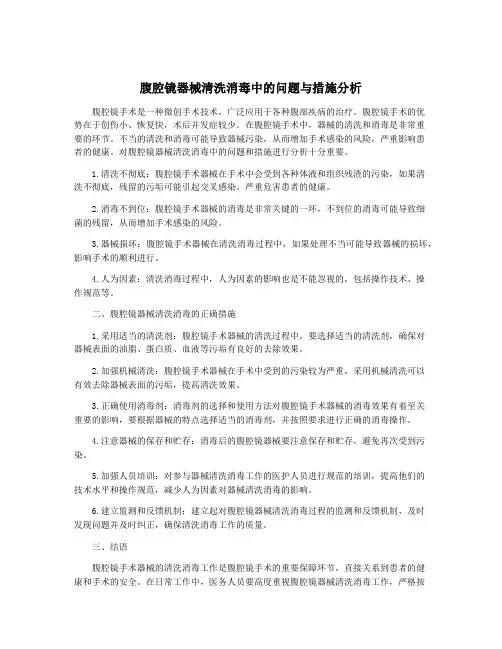
腹腔镜器械清洗消毒中的问题与措施分析腹腔镜手术是一种微创手术技术,广泛应用于各种腹部疾病的治疗。
腹腔镜手术的优势在于创伤小、恢复快,术后并发症较少。
在腹腔镜手术中,器械的清洗和消毒是非常重要的环节。
不当的清洗和消毒可能导致器械污染,从而增加手术感染的风险,严重影响患者的健康。
对腹腔镜器械清洗消毒中的问题和措施进行分析十分重要。
1.清洗不彻底:腹腔镜手术器械在手术中会受到各种体液和组织残渣的污染,如果清洗不彻底,残留的污垢可能引起交叉感染,严重危害患者的健康。
2.消毒不到位:腹腔镜手术器械的消毒是非常关键的一环,不到位的消毒可能导致细菌的残留,从而增加手术感染的风险。
3.器械损坏:腹腔镜手术器械在清洗消毒过程中,如果处理不当可能导致器械的损坏,影响手术的顺利进行。
4.人为因素:清洗消毒过程中,人为因素的影响也是不能忽视的,包括操作技术、操作规范等。
二、腹腔镜器械清洗消毒的正确措施1.采用适当的清洗剂:腹腔镜手术器械的清洗过程中,要选择适当的清洗剂,确保对器械表面的油脂、蛋白质、血液等污垢有良好的去除效果。
2.加强机械清洗:腹腔镜手术器械在手术中受到的污染较为严重,采用机械清洗可以有效去除器械表面的污垢,提高清洗效果。
3.正确使用消毒剂:消毒剂的选择和使用方法对腹腔镜手术器械的消毒效果有着至关重要的影响,要根据器械的特点选择适当的消毒剂,并按照要求进行正确的消毒操作。
4.注意器械的保存和贮存:消毒后的腹腔镜器械要注意保存和贮存,避免再次受到污染。
5.加强人员培训:对参与器械清洗消毒工作的医护人员进行规范的培训,提高他们的技术水平和操作规范,减少人为因素对器械清洗消毒的影响。
6.建立监测和反馈机制:建立起对腹腔镜器械清洗消毒过程的监测和反馈机制,及时发现问题并及时纠正,确保清洗消毒工作的质量。
三、结语腹腔镜手术器械的清洗消毒工作是腹腔镜手术的重要保障环节,直接关系到患者的健康和手术的安全。
在日常工作中,医务人员要高度重视腹腔镜器械清洗消毒工作,严格按照操作规程进行操作,确保腹腔镜器械清洗消毒工作的质量和安全。
腹腔镜器械的清洗消毒灭菌与管理摘要】随着医学的不断发展,腹腔镜的使用日益频繁,由此器械的清洗,灭菌与管理尤为重要。
如何使器械保持良好的功能和使用价值,延长使用寿命减少损坏,从而降低医疗成本。
现在微创手术增多,在手术过程中精密器械的使用率也大幅提升,可是手术结束后的器械上存在大量血迹及脓迹,要是不能完全清洗干净的话,消毒灭菌将毫无效果,存在院内感染的危险。
为提高腹腔镜器械的清洗程度,是器械达到真正的消毒灭菌,保证患者手术安全,我院对腹腔镜等微创器械使用严密的清洗消毒制度,及低温等离子灭菌。
自开展腹腔镜手术以来无一例院内感染的发生。
【关键词】腹腔镜器械;清洗;消毒灭菌;管理【中图分类号】R197.32 【文献标识码】A 【文章编号】1007-8231(2016)25-0238-021.腹腔镜器械的清洗1.1 清洗人员对于腹腔镜器械使用前有专业人员对手术室洗手和巡回护士进行专门的培训,了解并掌握器械的构造、拆卸、安装及如何使用。
清洗人员在清洗过程中一定要戴口罩、帽子和专用的防护面罩、围裙、乳胶手套,严格按照要求做好个人防护。
我院采用纯手工清洗,加强清洗人员的责任心,实施各环节的精细化操作,合格率达100%。
1.2 腹腔镜器械的清洗腹腔镜器械的清洗是消毒灭菌的一个重要的环节。
通过清洗能去除器械90%以上的病原菌,但在清洗过程中对效果的影响因素有很多,如腹腔镜受到的污染及污染物的干燥程度,腔镜器械构造的复杂程度,管腔长,清洗方法,酶的选择等。
洗手护士在手术结束后立即将器械拆卸成最小易清洗结构,小零件放置在小盒内以免丢失,浸泡在专用加酶洗涤剂中,分开放置,充分浸泡,用酶清洗时水温控制在20~40℃时酶活性最强,水温低会影响其活性。
然后用流动水认真冲洗每一个零部件,管腔用软毛刷反复刷洗,以两端见到刷毛为准,彻底清除组织碎片,清洗干净后用流动水反复冲洗,然后放置在专用润滑油里浸泡2分钟后取出,打开各关节,管腔充分晾干,放在专用储存柜中准备消毒灭菌[1]。
如何做好腹腔镜器械的清洗,消毒与保养?腹腔镜作为新型微创技术之一,因具有视野广、精确度高、图像清晰等特点,故得到临床的广泛应用,但是,腹腔镜手术器械多为高精度器械,不易拆装清洗,术后清洗、消毒不当易引起交叉感染,而腹腔镜器械保养不当则会影响其使用寿命,其中任何一个环节不到位都会降低手术安全性,影响医疗质量,因此,如何做好腹腔镜器械清洗、消毒与保养工作现已成为临床重点研究问题,本文对此展开深入剖析,期望帮助临床提高医疗器械使用安全性与经济性。
一、腹腔镜器械的清洗清洗是消毒、灭菌中的重要环节,有效清洗可去除90%以上的病原体,而在清洗时应根据腹腔镜器械的性能、结构等选择不同的清洗方法,为了获得最为理想的清洗效果,在清洗剂、清洗工具和清洗方法方面都需要特殊的要求。
1.清洗剂和工具腹腔镜器械是一种十分精密的器械,清洗要求比较高,在清洗剂和清洗工具的选择上理应慎重,建议首选具有超强去污能力的多酶清洗液,该清洗液能够快速分解糖类、脂肪、蛋白质以及碳水化合物等人体分泌物,有助于节省清洗时间。
清洗工具则应选择而高压水枪、高压气枪、软毛刷、擦镜纸、软清洁布、烘干机等。
1.清洗方法目前临床常用的清洗方法主要有两种,其一为手工清洗法,将使用后的腹腔镜器械拆卸到最小单位,使用流动清水冲洗,去除血迹,流动清水冲洗后使用高压水枪彻底冲洗,尤其是各个管腔。
冲洗后将器械放入多酶清洗液中,浸泡时间大约需要5--10分钟,浸泡后取出器械使用软毛刷刷洗,重点刷洗器械管腔、轴节、前段齿槽部分,在流动清水下漂洗,使用高压水枪冲洗管腔,冲洗后使用软清洁布擦拭,烘干机烘干,管腔未干的情况可使用高压气枪吹干,随后将器械置入润滑剂内浸泡,浸泡时间为30秒,以形成保护层。
对于导线、光学器械,则应使用蘸有多酶清洗液的软清洁布擦拭血迹,再用清水擦干,镜头需要使用专用擦镜纸沿着同一个方面擦拭干净,避免磨损镜面。
其二为超声清洗法,清洗、浸泡过程均于手工清洗法相同,浸泡后将器械擦干置入超声清洗器中清洗,后续步骤同手工清洗法,相较于手工清洗法,超声清洗法清洗时间短、清洁度更高,适用于对清洗要求较高的精密仪器,而手工清洗法则更适合非精密繁复零件。